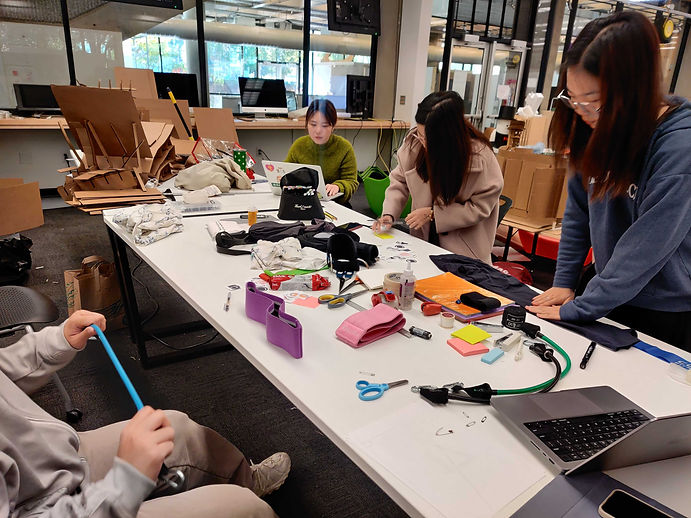

KneeTect
Georgia Tech | Wearable Technology
Role: UX Designer | UX Researcher
Group Project | Team of 4 | Duration: 4 months | Completion: December 2023
Solo lower-body strength training is challenging and dangerous for novices.
Young adults who want to start lower-body strength training encounter challenges in choosing suitable exercises, executing them with proper form, and harboring concerns about the risk of injury.

The Problem


"Lower-body strength training alone is challenging without proper guidance and supervision, leading to slow progress or even adverse outcomes like overtraining and injuries."
Group Project | Team of 4 | Duration: 4 months | Completion: December 2023
Background Research
The top three challenges reported by participants are incorrect form, injuries, and difficulty in tracking progress.

Key Findings on Focal Points
Target Audience: Age 18-34 | all genders | Lower-Body strength training.
-
Difficulties in sustaining/monitoring body posture while working out.
-
Ways to follow / execute lower-body strength training plan.
-
Various ways of coping with boredom or fatigues
-
Trials and errors in choosing the right weights
-
Lower-body Strength Training Plan Customization.
Online Surveys w/ 45 Responses
Key Findings on Focal Points
-
A majority, 55% prioritize lower body strength training.
-
A significant 69% feel confident and well-versed in lower body exercises.
-
At least 75% participants prefer to use free weights and machines for strength training.
-
62.5% participants rely on their memory and 37% online tutorials for guidance during workouts.
-
The top three challenges reported by participants are incorrect form, injuries, and difficulty in tracking progress.
-
Participants find the most value in their training through the positive impact on their bodies, improved posture, and the satisfaction of completing their workouts.
8 Semi-structed Interviews
GOALS:

User Interviews










User Surveys
Target Audience: Age 18-34 | all genders | Lower-Body strength training.
Goals
-
Gain insights into diverse individuals' requirements and objectives regarding lower-body strength training.
-
Delve further into current methodologies in the planning, execution, and monitoring of lower-body strength training, with a particular emphasis on the execution phase.
-
Explore the obstacles encountered during the planning, execution, and tracking of lower-body strength training, with a specific focus on the execution phase.

Define
Young adults who want to start lower-body strength training encounter challenges in choosing suitable exercises, executing them with proper form, and harboring concerns about the risk of injury.
Persona Development



Theoretical + Technical Research

Relevant Technologies

Shared Ideas: Posture Monitoring Wearable + Companion App
-
Before workout: Personalize simple, straightforward, and streamlined training plan that suit multifaceted requirements
-
During workout:
-
Guide suitable exercise forms and notify improper forms
-
Flexible training plan adaptations based on on-the-spot conditions
-
Real-time, intuitive guidance during training and notifications to avoid potential injuries
-
-
After workout: Reflect on training performance and suggest for improvements
-
User body (Muscle freshness) monitoring + Smart exercise suggestions / adjustments
-
Short-term and long-term progress visualizations
-



-
Different exercise forms to be detected: knee angle, speed, weight, etc
-
Different modalities of feedback during training: Audio, Visual, Light, Haptic, etc
-
Different forms of the wearable: Inserted into clothes, attached to knee braces, attached to elastical bands, etc
Ideation
Co-design workshop based on Sanders’ four-step framework with generative toolkits. As a result, we could have valuable insights from the workshop. From the workshop, we didn't just gain insights—we unearthed invaluable revelations through the fertile ground of collaborative exploration.







Generative Kit
From stationary to workout props and even printed electronic components, every element was strategically chosen to ignite participants' imaginations for each tasks.


Description: The participants were provided with the prompt “Think about your ideal guidance in your lower-body strength training”. They were asked to express themselves by preparing a short storyboard.


Following Tutorials: It was seen that most participants desired to get a visual of the tutorial before starting the exercise.
Monitoring & Posture correction: Participants had interesting approaches where they considered getting AR feedback on posture correction, showing exactly where one needs to improve.
Pace adjustment: A few participants considered adjusting their pace, they were seeking pace adjustment from the guidance tutorial and/or have a music beat which could set a pace for the tutorial.


Task Two
Participants asked .. 'Imagine that you can have a wearable to monitor your lower-body strength training postures, brainstorm your dream device.'




-
Portability: Participants desired the wearable to be portable, lightweight / small, and easy to put on/off.
-
Safety: Knees were top1 body parts that participants wanted to monitor the posture and protect, following by lower-back and wrist.
-
Aesthetics: Participants wanted such wearable to be less conspicuous, but more “blended” with their clothes.
-
Ergonomics: Participants wanted it to be comfortable to wear and easily customize the length/tightness to suit their body sizes.
-
Intuitiveness: Participants preferred multimodal feedback, especially haptic feedback and audio feedback for notifications, which are hands-free and eyes-free.
-
Ease to Maintain: Participants were concerned about washing the wearable, changing the battery, etc.

Key Tasks
Refined Goal: Help unconfident novices master strength training (particularly lower-body strength training) with inclusive and adaptive coaching.
Specifically, designing a system to assist novices in effortlessly tailoring their lower-body strength training plan, learning proper exercise techniques with intuitive, adaptive guidance, and maintaining their training efforts with confidence.

Prototype

Wearable:
-
Knee brace with strips to adjust the tightness
-
Sensor module that can be attached/detached
-
Flexible battery that can be put in/out of the wearable
-
Vibration engines that can provide haptic Feedback
-
Button that can turn on/off the wearable and can press to control the tutorial (pause/go to next one)
Companion App
-
AI generated workout plans
-
Visual tutorials
-
Real-time visual feedback
-
Personalized suggestion
-
Overall report






Usability Testing


Results

